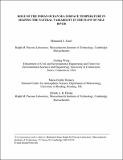Role of the Indian Ocean sea surface temperature in shaping the natural variability in the flow of Nile River
Author(s)
Demory, Marie-Estelle; Eltahir, Elfatih A. B.; Siam, Mohamed Salah; Wang, Guiling, 1971-
Download382_2014_2132_ReferencePDF.pdf (1.149Mb)
OPEN_ACCESS_POLICY
Open Access Policy
Creative Commons Attribution-Noncommercial-Share Alike
Terms of use
Metadata
Show full item recordAbstract
A significant fraction of the inter-annual variability in the Nile River flow is shaped by El Niño Southern Oscillation (ENSO). Here, we investigate a similar role for the Indian Ocean (IO) sea surface temperature (SST) in shaping the inter-annual variability of the Nile River flow. Using observations of global SST distribution and river flow in addition to atmospheric general circulation model sensitivity experiments, we show that North and Middle IO SSTs play a significant intermediate role in the teleconnection between ENSO and the Nile flow. Applying partial coherency analyses, we demonstrate that the connection between North and Middle IO SSTs and Nile flow is strongly coupled to ENSO. During El Niño events, SST in the North and Middle IO increases in response to the warming in the Tropical Eastern Pacific Ocean and forces a Gill-type circulation with enhanced westerly low-level flow over East Africa and the Western IO. This anomalous low-level flow enhances the low-level flux of air and moisture away from the Upper Blue Nile (UBN) basin resulting in reduction of rainfall and river flow. SSTs in the South IO also play a significant role in shaping the variability of the Nile flow that is independent from ENSO. A warming over the South IO, generates a cyclonic flow in the boundary layer, which reduces the cross-equatorial meridional transport of air and moisture towards the UBN basin, favoring a reduction in rainfall and river flow. This independence between the roles of ENSO and South IO SSTs allows for development of new combined indices of SSTs to explain the inter-annual variability of the Nile flow. The proposed teleconnections have important implications regarding mechanisms that shape the regional impacts of climate change over the Nile basin.
Date issued
2014-04Department
Massachusetts Institute of Technology. Department of Civil and Environmental Engineering; Parsons Laboratory for Environmental Science and Engineering (Massachusetts Institute of Technology)Journal
Climate Dynamics
Publisher
Springer Berlin Heidelberg
Citation
Siam, Mohamed S., Guiling Wang, Marie-Estelle Demory, and Elfatih A. B. Eltahir. “Role of the Indian Ocean Sea Surface Temperature in Shaping the Natural Variability in the Flow of Nile River.” Climate Dynamics 43, no. 3–4 (April 17, 2014): 1011–1023.
Version: Author's final manuscript
ISSN
0930-7575
1432-0894